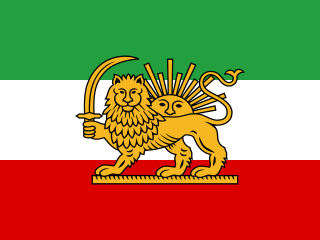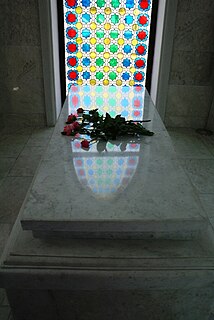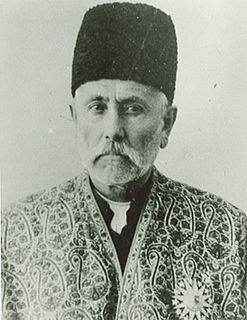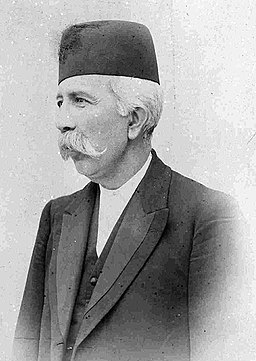
Tabriz is the most populated city in northwestern Iran, one of the historical capitals of Iran and the present capital of East Azerbaijan province. It is the sixth most populous city in Iran. Located in the Quru River valley, in Iran's historic Azerbaijan region, between long ridges of volcanic cones in the Sahand and Eynali mountains, Tabriz's elevation ranges between 1,350 and 1,600 metres above sea level. The valley opens up into a plain that gently slopes down to the eastern shores of Lake Urmia, 60 kilometres to the west. With cold winters and temperate summers, Tabriz is considered a summer resort. It was named World Carpet Weaving City by the World Crafts Council in October 2015 and Exemplary Tourist City of 2018 by the Organisation of Islamic Cooperation.

The Qajar dynasty was an Iranian royal dynasty of Turkic origin, specifically from the Qajar tribe, which ruled Persia (Iran) from 1789 to 1925. The state ruled by the dynasty was officially known as the Sublime State of Persia. The Qajar family took full control of Iran in 1794, deposing Lotf 'Ali Khan, the last Shah of the Zand dynasty, and re-asserted Iranian sovereignty over large parts of the Caucasus. In 1796, Mohammad Khan Qajar seized Mashhad with ease, putting an end to the Afsharid dynasty, and Mohammad Khan was formally crowned as Shah after his punitive campaign against Iran's Georgian subjects. In the Caucasus, the Qajar dynasty permanently lost many of Iran's integral areas to the Russians over the course of the 19th century, comprising modern-day Georgia, Dagestan, Azerbaijan and Armenia.

Agha Mohammad Khan Qajar, also known by his regnal name of Agha Mohammad Shah, was the founder of the Qajar dynasty of Iran, ruling from 1789 to 1797 as king (shah). Originally chieftain of the Qoyunlu branch of the Qajar tribe, Agha Mohammad Khan was enthroned as the king of Iran in 1789, but was not officially crowned until March 1796, having deposed Lotf Ali Khan of the Zand dynasty in 1794. Agha Mohammad Khan Qajar was famously the eunuch Monarch, being castrated as a young adult upon his capture by Adel Shah Afshar, and hence was childless. On June 17, 1797, he was assassinated, and was succeeded by his nephew, Fath-Ali Shah Qajar.

Fath-Ali Shah Qajar was the second Shah of Iran. He reigned from 17 June 1797 until his death. His reign saw the irrevocable ceding of Iran's northern territories in the Caucasus, comprising what is nowadays Georgia, Dagestan, Azerbaijan, and Armenia, to the Russian Empire following the Russo-Persian Wars of 1804–13 and 1826–28 and the resulting treaties of Gulistan and Turkmenchay. Historian Joseph M. Upton says that he "is famous among Persians for three things: his exceptionally long beard, his wasp-like waist, and his progeny."

The Battle of Krtsanisi was fought between the Qajars of Iran and the Georgian armies of the Kingdom of Kartli-Kakheti and Kingdom of Imereti at the place of Krtsanisi near Tbilisi, Georgia, from September 8 to September 11, 1795, as part of Qajar Emperor Agha Mohammad Khan Qajar's war in response to King Heraclius II of Georgia’s alliance with the Russian Empire. The battle resulted in the decisive defeat of the Georgians, capture, and complete destruction of their capital Tbilisi, as well as the temporary absorption of eastern parts of Georgia into the Iranian Empire.

Arg of Tabriz, is the remnants of a big fortification and city wall in downtown Tabriz. Ark's structure is visible from far distances in downtown of Tabriz, if not blocked by newly high raised building.

Prince Iraj Mirza, son of prince Gholam-Hossein Mirza, was a famous Iranian poet. He was a modern poet and his works are associated with the criticism of traditions. He also made translation of literary works from French into Persian.

Yeprem Khan, born Yeprem Davidian, was an Iranian-Armenian revolutionary leader and a leading figure in the Constitutional Revolution of Iran. He is considered a national hero in Iran.

Donboli are a Turkic-speaking sub-ethnic group of Kurds originality in the Khoy khanate and Tabriz khanate regions of West Azarbaijan Province of Iran.

Ghassem Khan Vali, otherwise and better known by his military title of Sardar Homayoun, the son of Ali Khan Vali and grandson of Mohamad Ghassem Khan Vali was the first Imperial Iranian Army general to graduate from the prestigious Saint-Cyr Military School in France, which was founded by Napoléon in 1802. During the Overthrow of the Qajar dynasty, Sardar Homayoun was encouraged by the local politicians and moderates, backed by Edmund Ironside, 1st Baron Ironside and the British Government, to become the Shah of Persia. He mainly declined out of his loyalty to Ahmad Shah, although it was stated that it was out of his fear for his family's safety and his moral reluctance to use force against his countrymen, a measure which was inevitable for the maintenance of the monarchy. His reluctance was seen as cowardice by the British, and so the position was later given to Reza Shah Pahlavi.

Jafar al-Javad Khan Ziyad oghlu Qajar was a member of the Qajar dynasty, and the last khan of the Ganja khanate from 1786 to 1804.

The Amir Nezām House, or The Qajar Museum of Tabriz, is a historical building in the Sheshghelan district, one of the oldest quarters of the city of Tabriz, Iran. The base of the edifice covers an area of 1200 square metres. This monument which since 2006 houses a museum dedicated to the Qajar dynasty (1781-1925), was built in the period of the Crown Prince Abbas Mirza (1789-1833). It was renovated by Hasan-Ali Khan, Hasan Ali Khan Garroosy, in his position as the Major-domo of Azarbaijan, and used as his residency. In the subsequent periods, the house was employed as the official residence of the provincial governors of Azarbaijan. Because of persistent neglect over a long period of time, this building had come to be in such a bad state of disrepair that for a time it was seriously considered to demolish it and build a school in its place. Between 1993-2006 it has been subject of an extensive renovation process and since the completion of this undertaking it has been granted the National Heritage status.

Samad Khan Momtaz os-Saltaneh, or Momtaz ol Saltaneh was an Iranian diplomat of the Qajar and Pahlavi dynasty era.

The Persian Constitutional Revolution, also known as the Constitutional Revolution of Iran, took place between 1905 and 1911. The revolution led to the establishment of a parliament in Persia (Iran) during the Qajar dynasty.

Bahman Mirza was a Persian prince of the Qajar Dynasty, son of Abbas Mirza and grandson of Fath Ali Shah. He was Vicergerent (vali) of Azerbaijan and Governor-General of Tabriz. He later migrated to neighboring Imperial Russia, where he was received with great honor and lived a prestigious life in Shusha. Many of his offsprings either returned to Iran where they had political or military careers, or served in the Russian military, and later played an important role in the military of Azerbaijan Democratic Republic. Beside political figures, he is also the great grandfather of Afrasiyab Badalbeyli, Azerbaijani composer and author of the first Azeri balet and the first ballet in the Muslim East.
1921 Persian coup d'état, known in Iran as 3 Esfand coup d'état, refers to several major events in Persia in 1921, which eventually led to the establishment of the Pahlavi dynasty as the ruling house of the country in 1925.

Mohammad Hasan Khan Qajar, also spelled Muhammad and Hassan (1722–1759), chief of the Qoyunlu branch of the Qajar tribe of Turkomans in the Caspian coastlands around Astarabad, was the son of Fath Ali Khan and the father of Agha Mohammad Khan Qajar, who founded the Qajar dynasty of Iran.
The Tabriz khanate was one of the Caucasian khanates, located in historic Azerbaijan which became for nearly fifty years semi-independent from the Iranian mothercountry.
Khoy Khanate was an Iranian khanate in the province of Azerbaijan. The city of Khoy was inhabited and ruled by the Donboli clan, a Kurdish tribe originally from Anatolia, since the 14th century B.C. In 1530 Hajji Beg Donboli, son of Sheikh Ahmad Beg, received the rule over Khoy and Sokmanabad on behalf of the Safavid Shah Tahmasp II and could establish his family's rule over the whole area and finally also over the city of Tabriz, where another branch ruled the Tabriz Khanate.

The Bahmani family, also Bahmani-Qajar is an aristocratic Persian family belonging to one of the princely families of the Qajar dynasty, the ruling house that reigned Iran 1785–1925. The founder is Bahman Mirza Qajar (1810–1884), younger brother of Mohammad Shah Qajar and formerly prince regent and governor of Azerbaijan 1841–1848.






















